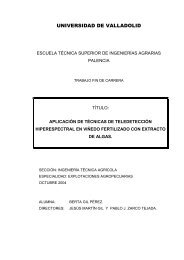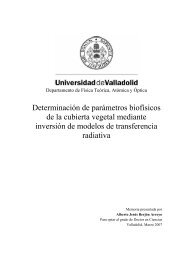10th INTERNATIONAL VERTICILLIUM SYMPOSIUM 16-20 ...
10th INTERNATIONAL VERTICILLIUM SYMPOSIUM 16-20 ...
10th INTERNATIONAL VERTICILLIUM SYMPOSIUM 16-20 ...
Create successful ePaper yourself
Turn your PDF publications into a flip-book with our unique Google optimized e-Paper software.
AN OVERVIEW OF VEGETATIVE COMPATIBILITY GROUPSOF <strong>VERTICILLIUM</strong> DAHLIAE FROM COTTON IN TURKEY,INCLUDING NEW ISOLATESDERVIS S. 1 , ERTEN L. 2 , KURT S. 1 , YILDIZ M. 31 Mustafa Kemal University, Department of Plant Protection, Faculty of Agriculture, 31034 Antakya,Hatay, Turkey;2 Olive Research Institute, Turkish Ministry of Agriculture and Rural Affairs, 35100 Bornova, Izmir,Turkey;3 Ege (Aegean) University, Department of Plant Protection, Faculty of Agriculture, 35100 Bornova,İzmir, TurkeyCotton (Gossypium hirsutum L.) is the most important field crop in the southern(Mediterranean part), southeastern and western Anatolia of Turkey. Considering thesevere wilting of cotton plants observed and the presence of D pathotype in theseregions and the role of VCGs proved for pathogenicity of the isolates, objective ofthis research was to strengthen a proper sight of the disease in all cotton areas ofTurkey together with VCG results of 139 new and 254 previously reported isolates(not characterized or self-incompatible isolates were not included in these numbers).To summarize all findings of genetic diversity studies that have been conducted in thelast 10 years, among 393 isolates, 42.0% of total belonged to VCG1A, 42.0% toVCG2B, 13.5% toVCG2A and 2.5% to VCG4B. The highly virulent form of V.dahliae resulting very severe disease in cotton consisted of VCG1/D and VCG2B/PDpathotypes and this type was detected in 84% of the affected fields. Mild-to-moderatedisease in other fields was dominated by VCG2A/ND, with VCG4B/ND as a minorcomponent. Newly collected isolates from some areas revealed no considerabledifference in VCG pattern of V. dahliae isolates from the same locations over years.Majority of the isolates (61.1% of 113 isolates) from the Mediterranean part belongedto VCG2B, 28.3% to VCG2A, 5.3% to VCG1A and 5.3% to VCG4B. Among 198isolates from the western Anatolia, 57.6% belonged to VCG1A, 32.3% to VCG2B,8.1% to VCG2A and 2.0% to VCG4B. 54.9% of 82 isolates from the southeasternAnatolia belonged to VCG1A, 39.0% to VCG2B and 6.1% to VCG2A. A correlationbetween vegetative compatibility and geographical provenance of the isolates wereobserved: VCG1A was dominant in the western and southeastern Anatolia but rarelyfound in the Mediterranean region; on the other hand, VCG2B was dominant in theMediterranean part but had lower provenance in the western and southeasternAnatolia regions.99




